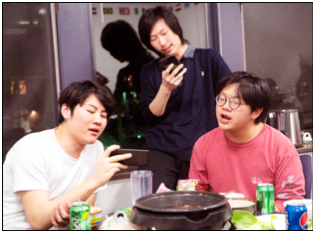By Jack Donahue
In the depths of McCarthy you might stumble upon a room with a damp basement smell, chocolate brown walls and a fading lime green tile floor. It could almost be mistaken as a giant storage room with the amount of chairs and other items lying around in no particular order. It’s dark, disorganized, and empty of all things that wouldn’t exactly define a theatre but it’s not as much about the space as it is about the people who fill it that make the Trap Door Theatre what it is.
The Trap Door Theatre, or TDT as it is affectionately referred to by theater students, is a small performing space beneath the main stage in the McCarthy basement. The TDT differs from a regular theater in that there is no raised stage or curtains but is simply an empty black room. While this may not sound like any sort of space you’d expect to see a play, its emptiness offers an opportunity for theater majors and the drama club to experiment with staging and storytelling to offer audiences a unique theater going experience.
The Trap Door Theatre got its name back in the winter of 2013 when then student Jillian Holland won a theatre-name-contest that was held for the space. But the history goes back far beyond that. “Students have been staging performances in the TDT (Trap Door Theatre) space since at least 1980 (when I was in one there myself),” said Peter Harrigan, a professor of fine arts in the theatre department. “In order to get the more intimate and sometimes gritty feel of a smaller performance space.
About five years ago the TDT really started to bend into shape with the theatre department gradually purchasing more chairs along with curtains and flooring tiles. Their biggest development was painting the walls a dark chocolate brown.
“Professor John Devlin wisely suggested that a black room in the basement might be a bit grim,” Harrigan said, “and the great people of the SMC Physical Plant staff went along with our unusual suggestion to paint the walls, doors and ceiling a very dark color.”
All of these renovations have helped students use the TDT frequently.
“It’s the best space because it’s so versatile and so tight and intimate,” said Pat Cornacchio, a senior theater major who is currently rehearsing for his senior seminar show The Wood Raised Boy which he has been writing for the past two and a half years. It will premiere in the TDT on November 17. “It makes the audience way more engaged with what’s happening.”
Demora Dessert is another theatre major who is currently rehearsing for her senior seminar a performance of 4 a.m. written by Jonathan Dorf premiering on Oct. 27 and has been working in the TDT since her freshmen year. In the TDT, she said, “you focus less on projection for actors and more on the experience.”
There are challenges with working in this type of area: unlike on the Main Stage, directors and designers have far more limited space meaning they have to come up with creative solutions.
“I think it also frees people up, creatively,” said Harrigan, “If you are doing a show on the Main Stage, the proscenium arch [The arch framing the opening between the stage and the audience] alone is 36’ wide, and the audience has an expectation that you are going to fill it with something. Working in the TDT, one is released from that expectation and can focus on the essential element, which is the story-telling.”
For new students who are interested in using this space there is an improv club held in the TDT every Thursday at 9 p.m. that is open to everyone. Cornacchio spoke a little about this club saying, “Improv is the best way to get involved, You don’t have to participate you can just watch.”
Summing up what the TDT is all about, Harrigan said, “It is a great laboratory space for students to try things, and a great place for audiences to get within spitting distance (literally) of the actors, and experience a different type of theatre.”


